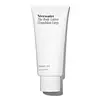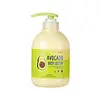What's inside
What's inside
 Key Ingredients
Key Ingredients

No key ingredients
 Benefits
Benefits

 Concerns
Concerns

 Ingredients Side-by-side
Ingredients Side-by-side

Water
Skin ConditioningGlycerin
HumectantCaprylic/Capric Triglyceride
MaskingDicaprylyl Carbonate
EmollientShea Butter Glycerides
EmulsifyingSimmondsia Chinensis Seed Oil
EmollientNiacinamide
SmoothingCetearyl Olivate
Cetearyl Alcohol
EmollientGlyceryl Stearate
EmollientSorbitan Olivate
EmulsifyingPalmitoyl Dipeptide-5 Diaminobutyroyl Hydroxythreonine
Skin ConditioningPalmitoyl Dipeptide-5 Diaminohydroxybutyrate
Skin ConditioningPalmitoyl Hexapeptide-12
Skin ConditioningPalmitoyl Tetrapeptide-7
Skin ConditioningPalmitoyl Tripeptide-1
Skin ConditioningSclerocarya Birrea Seed Oil
HumectantCaryodendron Orinocense Seed Oil
EmollientLimnanthes Alba Seed Oil
Skin ConditioningTocopherol
AntioxidantLinoleic Acid
CleansingLinolenic Acid
CleansingPropanediol
SolventPolyacrylate Crosspolymer-6
Emulsion StabilisingCaprylhydroxamic Acid
Caprylyl Glycol
EmollientT-Butyl Alcohol
PerfumingOleic Acid
EmollientPalmitic Acid
EmollientStearic Acid
CleansingWater, Glycerin, Caprylic/Capric Triglyceride, Dicaprylyl Carbonate, Shea Butter Glycerides, Simmondsia Chinensis Seed Oil, Niacinamide, Cetearyl Olivate, Cetearyl Alcohol, Glyceryl Stearate, Sorbitan Olivate, Palmitoyl Dipeptide-5 Diaminobutyroyl Hydroxythreonine, Palmitoyl Dipeptide-5 Diaminohydroxybutyrate, Palmitoyl Hexapeptide-12, Palmitoyl Tetrapeptide-7, Palmitoyl Tripeptide-1, Sclerocarya Birrea Seed Oil, Caryodendron Orinocense Seed Oil, Limnanthes Alba Seed Oil, Tocopherol, Linoleic Acid, Linolenic Acid, Propanediol, Polyacrylate Crosspolymer-6, Caprylhydroxamic Acid, Caprylyl Glycol, T-Butyl Alcohol, Oleic Acid, Palmitic Acid, Stearic Acid
Water
Skin ConditioningGlycerin
HumectantCetyl Ethylhexanoate
EmollientCetyl Alcohol
EmollientCyclopentasiloxane
EmollientCaprylic/Capric Triglyceride
MaskingButylene Glycol
HumectantPanthenol
Skin ConditioningPersea Gratissima Fruit Extract
EmollientCentella Asiatica Extract
CleansingPortulaca Oleracea Extract
Skin ConditioningCarica Papaya Fruit Extract
Skin ConditioningGlyceryl Stearate
EmollientStearyl Alcohol
EmollientCyclohexasiloxane
EmollientPEG-100 Stearate
PEG/PPG-17/6 Copolymer
SolventDimethicone
EmollientPalmitic Acid
EmollientStearic Acid
CleansingPolysorbate 60
EmulsifyingMyristyl Alcohol
EmollientCarbomer
Emulsion StabilisingArginine
MaskingLauryl Alcohol
EmollientXanthan Gum
EmulsifyingMyristic Acid
CleansingArachidic Acid
CleansingLauric Acid
CleansingOleic Acid
EmollientDisodium EDTA
Chlorphenesin
AntimicrobialEthylhexylglycerin
Skin Conditioning1,2-Hexanediol
Skin ConditioningParfum
MaskingLinalool
PerfumingLimonene
PerfumingHexyl Cinnamal
PerfumingButylphenyl Methylpropional
PerfumingGeraniol
PerfumingCitronellol
PerfumingWater, Glycerin, Cetyl Ethylhexanoate, Cetyl Alcohol, Cyclopentasiloxane, Caprylic/Capric Triglyceride, Butylene Glycol, Panthenol, Persea Gratissima Fruit Extract, Centella Asiatica Extract, Portulaca Oleracea Extract, Carica Papaya Fruit Extract, Glyceryl Stearate, Stearyl Alcohol, Cyclohexasiloxane, PEG-100 Stearate, PEG/PPG-17/6 Copolymer, Dimethicone, Palmitic Acid, Stearic Acid, Polysorbate 60, Myristyl Alcohol, Carbomer, Arginine, Lauryl Alcohol, Xanthan Gum, Myristic Acid, Arachidic Acid, Lauric Acid, Oleic Acid, Disodium EDTA, Chlorphenesin, Ethylhexylglycerin, 1,2-Hexanediol, Parfum, Linalool, Limonene, Hexyl Cinnamal, Butylphenyl Methylpropional, Geraniol, Citronellol
 Reviews
Reviews

Ingredients Explained
These ingredients are found in both products.
Ingredients higher up in an ingredient list are typically present in a larger amount.
This ingredient is an emollient, solvent, and texture enhancer. It is considered a skin-softener by helping the skin prevent moisture loss.
It helps thicken a product's formula and makes it easier to spread by dissolving clumping compounds.
Caprylic Triglyceride is made by combining glycerin with coconut oil, forming a clear liquid.
While there is an assumption Caprylic Triglyceride can clog pores due to it being derived from coconut oil, there is no research supporting this.
Learn more about Caprylic/Capric TriglycerideGlycerin is already naturally found in your skin. It helps moisturize and protect your skin.
A study from 2016 found glycerin to be more effective as a humectant than AHAs and hyaluronic acid.
As a humectant, it helps the skin stay hydrated by pulling moisture to your skin. The low molecular weight of glycerin allows it to pull moisture into the deeper layers of your skin.
Hydrated skin improves your skin barrier; Your skin barrier helps protect against irritants and bacteria.
Glycerin has also been found to have antimicrobial and antiviral properties. Due to these properties, glycerin is often used in wound and burn treatments.
In cosmetics, glycerin is usually derived from plants such as soybean or palm. However, it can also be sourced from animals, such as tallow or animal fat.
This ingredient is organic, colorless, odorless, and non-toxic.
Glycerin is the name for this ingredient in American English. British English uses Glycerol/Glycerine.
Learn more about GlycerinGlyceryl Stearate is a mix of glycerin and stearic acid.
It is used to stabilize the mixing of water and oil ingredients. By preventing these ingredients from separating, it can help elongate shelf life. It can also help thicken the product's texture.
As an emollient, it helps soften skin and supports barrier-replenishing ingredients.
In cosmetics, Glyceryl Stearate is often made from vegetable oils or synthetically produced.
This ingredient may not be fungal-acne safe
Fun fact: The human body also creates Glyceryl Stearate naturally.
Learn more about Glyceryl StearateOleic Acid is an Omega-9 fatty acid. It can be found in many plant oils such as avocado and marula oils.
This ingredient is used to enhance the texture of products and as a cleansing agent.
Oleic Acid may not be fungal acne safe.
Learn more about Oleic AcidPalmitic Acid is a fatty acid naturally found in our skin and in many plant and animal sources. In cosmetics, it is usually derived from palm oil. It serves many purposes in skincare, acting as a cleanser, emollient, and emulsifier.
As an emollient, palmitic acid helps soften and smooth the skin by preventing water loss. In cleansers, it helps remove oil and dirt while creating foam.
Its emulsifying properties help stabilize products by keeping water and oil-based ingredients from separating.
This may not be suitable for fungal acne-prone skin, as fatty acids like this can sometimes trigger breakouts in sensitive individuals.
Learn more about Palmitic AcidStearic Acid is a fatty acid. It is an emollient, emulsifier, and texture enhancer.
As an emollient, stearic acid helps soften skin. It aids the skin's protective barrier by preventing water loss. It also provides a gentle cleansing effect without stripping away natural oils.
Stearic acid may also be used to enhance the texture of products. It can add volume and stabilize ingredients such as water and oil. This can help water and oil ingredients from separating.
Sources of stearic acid include animal or vegetable fats/oils such as coconut or shea. It can be naturally found in butter, cocoa butter, shea butter, vegetable fats, and animal tallow.
This ingredient may not be Malassezia folliculitis, or fungal-acne safe.
Learn more about Stearic AcidWater. It's the most common cosmetic ingredient of all. You'll usually see it at the top of ingredient lists, meaning that it makes up the largest part of the product.
So why is it so popular? Water most often acts as a solvent - this means that it helps dissolve other ingredients into the formulation.
You'll also recognize water as that liquid we all need to stay alive. If you see this, drink a glass of water. Stay hydrated!
Learn more about Water